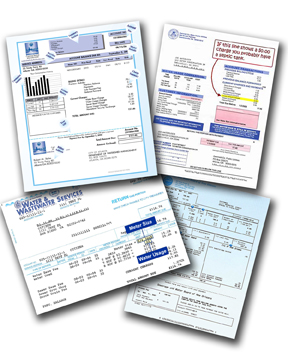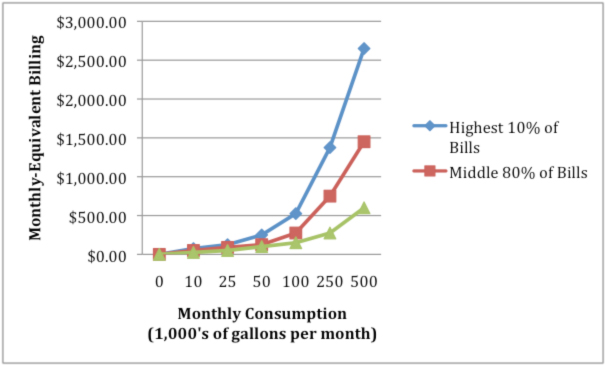
Most Georgians who receive water and/or sewer service from a public utility simply look at their monthly bill, find the total amount due, and write a check. But have you ever wondered how the total amount due is calculated? It might not be as simple as you think. That's because Georgia public utilities use a variety of base rates, variable rates and rate structures that often change as the amount of water consumption increases. By educating yourself on the basics of your utility's rates and rate structure, you can determine how your water bill is calculated, double check to make sure you are being charged the correct amount, and make the most cost-effective decisions for reducing your bill through water conservation. Answering these five questions can help you better understand your water bill:
- What Unit of Volume is used to measure my water consumption?
- What are my Base Rate charges for water and sewer?
- What Rate Structure does my public utility use if I exceed my base allowance?
- What River Basin am I located in within Georgia?
- Am I a Commercial or Industrial customer?
The easiest and often best way to find these answers is by simply calling your local provider. Most public utilities have staff members trained to answer questions about their rates and rate structure, or they can mail you printed materials. If you're comfortable using the Internet, many larger public utilities have Web sites that explain the local rates and rate structure in detail. Contacting your local utility is often the best choice to get the most recent information since rates and rate structures often change. In May 2008, the Georgia Environmental Finance Authority (www.gefa.org) in cooperation with the Environmental Finance Center (efc.sog.unc.edu) published a report titled “Water and Sewer Rates and Rate Structures in Georgia” along with an interactive Web site that summarizes a comprehensive survey of the state's public utilities. You can visit The Georgia Water and Sewer Survey Web site to find information on your specific public utility or to compare your local rates and rate structure to those of other Georgians. Although the main purpose of the survey, report and Web site is to help public utilities around the state set rates and rate structures based on up-to-date detailed data and trends, all Georgians can glean important information about the rates they and others pay for water and sewer services.
Question 1: What Unit of Volume is used to measure my water consumption?
Virtually all Georgia public utilities use meters that measure water volume in one of two units: gallons or cubic feet. Public utilities that use water meters to record flow in gallons usually set rates based on 1,000-gallon units, commonly referred to as “per thousand.” Public utilities using water meters that record flow in cubic feet usually set rates based on hundred-cubic-feet units, commonly referred to as “ccf.” To convert from one unit to the other you need to know that 1 ccf = 748 gallons.
My unit of volume measurement is: 1,000gallons ccf (circle one).
Most public utilities use a combination of base rate charges and variable rate charges in their rate structure. However, since there is considerable variation in how these charges are calculated and how they are applied to different classifications of customers, your next question needs to be:
Question 2: What are my Base Rate charges for water and sewer?
Base charges are the rates applied for receiving water and/or sewer service from a public utility regardless of the amount of water consumed or sewage released. Base charges are the stable monthly revenue source for public utilities since they do not vary with consumption. While almost every public utility in Georgia has base rates, the amounts vary widely by utility size. In general, larger utilities have lower base charges than smaller utilities because they have broader customer bases that provide a larger and more stable revenue base. As an example, in 2011, Georgia utilities serving populations greater than 25,000 had a median base monthly charge of $9.60 for water and $10.00 for sewer, while utilities serving populations below 1,000 had a median base monthly charge of $14.00 for water and $14.95 for sewer. The 2011 median residential base charge applied by all public utilities was $12.00 per month for water and $12.00 per month for sewer. The majority of public utilities include a minimum amount of water consumption and sewer disposal within their base charges. In Georgia, the median allowance for both water and sewer included in the base charge is 2,000 gallons per month.
My base WATER rate is: __________ per 1,000 gallons ccf (circle one)
My base SEWER rate is: __________ per 1,000 gallons ccf (circle one)
My WATER/SEWER base allowance is: ____________ gallons ccf (circle one)
Question 3: What Rate Structure does my public utility use if I exceed my base allowance?
Once you exceed the monthly base charge allowance volume, Georgia public utilities implement various variable charge structures. The most common types of variable charge structures are called uniform, increasing block and decreasing block. In a uniform rate structure, water and sewer charges do not change as the customer uses more water. In an increasing block structure, the rate increases as water consumption increases. This is the most popular variable rate utilities use to encourage water conservation. Conversely, a decreasing block structure charges customers a lower rate as water consumption increases. This type of rate structure is often used in areas that want to encourage economic development. Some Georgia utilities also use a hybrid of other variable charge structures, including increasing and decreasing blocks targeted at specific blocks of consumption, structures that are capped at a maximum billable consumption volume, tiered flat fees and seasonal rate structures. For many years, the trend among water and sewer rate structures in Georgia has been moving away from decreasing block to either uniform or increasing block structures. This trend has been motivated by the need to perverse water resources through promoting water conservation.
My Rate Structure is: ________________________________________
Question 4: What River Basin am I located in within Georgia?
 Figure 1. Median Water and Sewer Monthly Bills based on 6,000 GPM by River Basin. The highest median water charges are found in the Chattahoochee ($25.60) and Tennessee ($25.35) river basins, while the lowest are found in the Suwannee ($17.20) and Ochlockonee and Altamaha ($18.05) river basins. Lower median water charges are mostly found in rural areas of South Georgia where a significant number of small public utilities use groundwater sources. The highest median sewer charges are found in the highly urbanized Coosa ($31.40) and Tallapoosa ($30.65) river basins, while the lowest median sewer charges are found in the Ogeechee ($20.44) and Altamaha ($15.78) river basins.
Figure 1. Median Water and Sewer Monthly Bills based on 6,000 GPM by River Basin. The highest median water charges are found in the Chattahoochee ($25.60) and Tennessee ($25.35) river basins, while the lowest are found in the Suwannee ($17.20) and Ochlockonee and Altamaha ($18.05) river basins. Lower median water charges are mostly found in rural areas of South Georgia where a significant number of small public utilities use groundwater sources. The highest median sewer charges are found in the highly urbanized Coosa ($31.40) and Tallapoosa ($30.65) river basins, while the lowest median sewer charges are found in the Ogeechee ($20.44) and Altamaha ($15.78) river basins.Source: csat.er.usgs.gov/ga_epd/images/allbasins.png
Although this information isn't specifically needed to calculate your water and sewer rate, it is important to note that where you are located within Georgia plays an important role in your public utility rates, since source water quality and quantity play a significant role in the costs to produce safe drinking water. Similarly, water quality has a major impact on the cost of sewage treatment. The median water and sewer bills for consuming 6,000 gallons per month in each of Georgia's 14 major river basins are shown in Figure 1.
I am located in the ___________________ river basin.
Question 5: Am I a Commercial or Industrial customer?
Most Georgia public utilities use the same rate structure for commercial and industrial customers as they do for residential customers; however, almost 40 percent of utilities use a separate rate. A small fraction of these utilities further separate industrial and commercial customers and apply another unique rate structure. Although the majority of Georgia utilities use the same rate structure for all customers, many design variable blocks that inherently distinguish smaller residential customers from larger commercial and industrial customers. This is accomplished by setting the consumption rate within the base rate block high enough to essentially capture all residential users. Most large commercial and industrial customers will exceed this base level consumption block and thus be subjected to an increasing or decreasing block rate. When this type of variable rate structure is used, the base block consumption rate is typically set at 15,000 gallons per month.
I am / am not (circle one) a Commercial or Industrial customer.
 Figure 2. The median monthly water bill for Georgia commercial and industrial customers at increasing levels of consumption. Monthly charges are separated into the top and bottom 10 percent, as well as the middle 80 percent.
Figure 2. The median monthly water bill for Georgia commercial and industrial customers at increasing levels of consumption. Monthly charges are separated into the top and bottom 10 percent, as well as the middle 80 percent.
Status and Revision History
Published on Sep 01, 2009
Published with Minor Revisions on Jun 19, 2012


























































